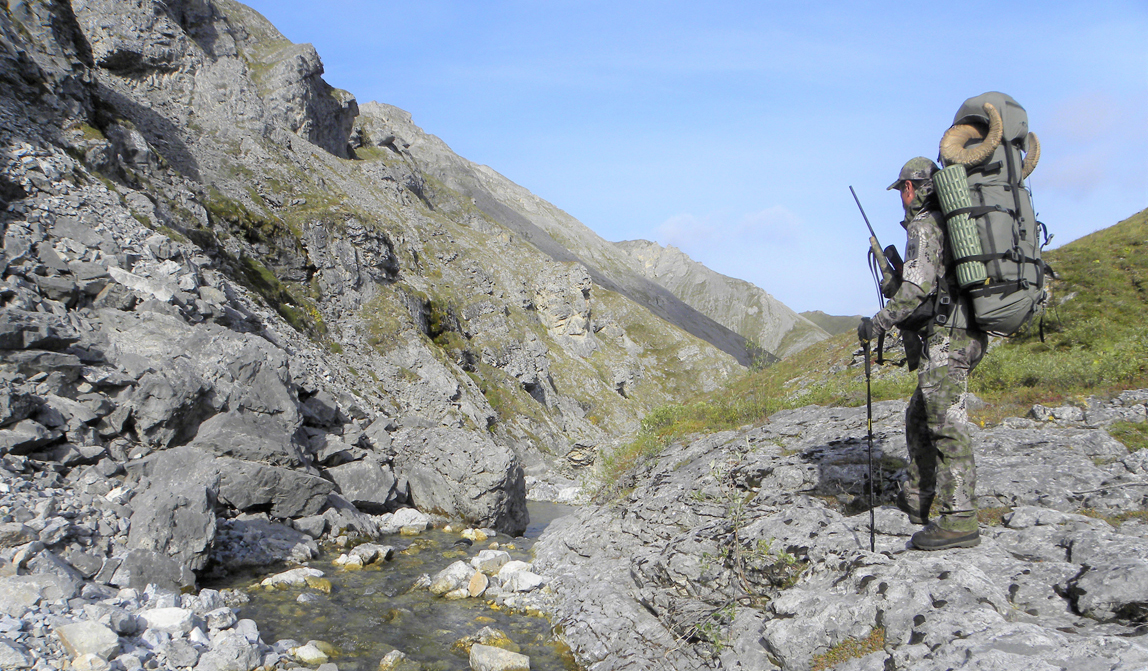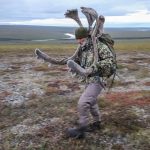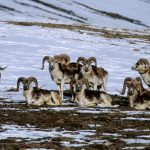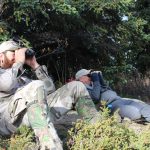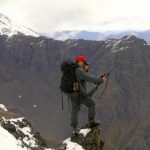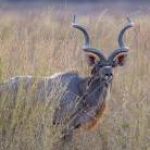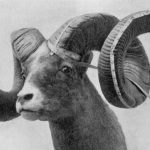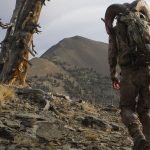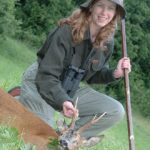A backpack hunt in a region so remote the sheep have never seen a human.
Ten yards. It sounds so close, but when you’re trying to slide on your back down a noisy talus slope in plain view of five bedded rams, it seemed like miles. I put my pack on my chest and my rifle on my pack and slowly began inching my way down to the small trough that would give me the view and rest I’d need for the three-hundred-yard shot. I willed myself to be invisible, but that didn’t take away the noise of the rough, hollow-sounding talus I was sliding over. Each time a stone would move with a loud clank, I’d freeze and look at the rams bedded below me. I was almost there when I looked down and one of the big full-curl rams was staring directly at me. All I could think was that I had just blown it.
I had met Lyle Becker years ago at one of the numerous conventions we both attend. We became great friends and I was excited for him when he bought his own outfitting territory and started Alaska Skookum Guides. It was about two years ago when I ran into Lyle at a show and asked him, “Do you have any Dall sheep?”
His response was, “No. Yes. Well, maybe . . . ”
Lyle explained the area he was hunting in the Brooks Range had not had any sheep tags in fourteen years, but he knew there were sheep in the area and was trying to get the state to allocate some tags. The thought of hunting rams that had most likely never been hunted in their lifetime was intriguing, an opportunity I didn’t think still existed. Moreover, I love going on exploratory hunts and I told Lyle I would love to be the “guinea pig” on his first sheep hunt to help him gauge the possibility of offering successful hunts to clients. More than a year later I finally heard from him.
“I got the tags,” he said. “Let’s do this.”
I knew from talking to Lyle and from previous experience that this was going to be a backpack hunt and a major undertaking. I would need the best gear and need to be in the best shape for this adventure. From the nearest landing strip we would be many miles on foot with only what we could carry on our backs. I gathered gear, checked my list, gathered more, weighed, tested, and as the hunt approached, I even ordered an HS Precision PHL rifle in 6.5 Creedmoor to shave three pounds off of what I normally carry. I had done everything–everything except the most important thing. Between work and family responsibilities, I had completely failed to work out, a cardinal sin in the world of mountain hunting. But I wanted this badly, and I prepared myself mentally for the challenge ahead.
After three days of travel I landed in Fort Yukon, Alaska, and was met by Lyle. A welcome sight, except that he was supposed to already be out in the field where I would fly in to meet him. Several days of bad weather had the bush planes all stacked up trying to get hunters out of the field. We were still a few days before season opener so though a small setback we enjoyed a little extra time to sort our gear and rest. At last we were flown out to a midway point where we were to be shuttled to a remote strip via Super Cub. It was here that I met our nineteen-year-old packer, Hunter Beiler. It didn’t take long to realize what an asset he would be on this adventure.
Our Cub pilot was still running behind so we had to spend an extra day at this midway point. Now we were starting to get concerned as we were losing hunting days. We passed the time glassing caribou and were visited by an almost pure white grizzly bear.
In one of our conversations, I asked Lyle, “So why the name Skookum Guides?”
He replied, “Up here it is a common term meaning larger, better, or exceptional.“
“I get it,” I said. “So we are looking for a skookum ram.”
“Exactly!” Lyle said.
After two days stuck in limbo, we heard a plane and out of the sky came Daniel Hayden of the TV show The Last Alaskans fame. Daniel flies for Wright Air Service and had heard we were stranded. He and Lyle hatched a plan B to get us where we needed to go. Instead of flying in with the Super Cub and walking up a valley to the hunting area, we would fly into a neighboring valley with an airstrip, walk over a low pass, and drop into the area from a different direction. It was too late to fly that night and the weather was sketchy, so he decided to spend the night there with us and fly us out the next day.
The next day we woke to low clouds that blocked our ability to fly through the passes to our destination. We impatiently waited as it was now opening day, and even if we got out we wouldn’t be able to hunt due to Alaska’s “no hunting on the same day you fly” rule. At last the clouds began to lift and we were in the air. Daniel flew us up a few different valleys before finding a pass open enough to allow safe passage. Safely at the strip, we mustered our gear, donned our heavy packs, and headed out.
Being more than a hundred miles above the Arctic Circle, we had 24-hour daylight, so even though we were getting a late start we trudged our way through a few miles of boot-sucking swamp and aggravating tussocks and made our way over the pass into the hunting area we had been trying to reach for days. Tomorrow we would finally be sheep hunting! We scouted out a dry knoll above the swamp, set up camp, ate supper, and crashed for the night.
The morning greeted us with fairly clear skies so we immediately began glassing. The recent spate of bad weather had a blanket of snow on the peaks, so while spotting white sheep would normally be easy on the dark mountains, now it was like trying to make out a Bev Doolittle painting. After breakfast we made a loop up a valley behind camp and began glassing at every vantage point for our quarry. Seeing neither sheep nor sheep sign, we decided to push on deeper into our target area.
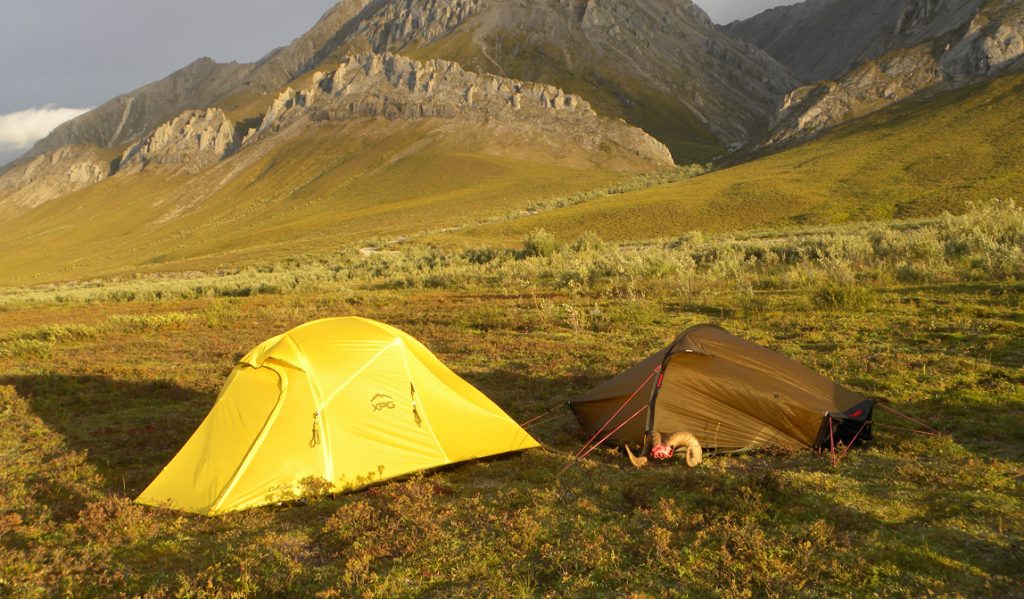
Sheep camp in the Brooks Range.
We broke camp and headed toward another pass a few miles off. Once out of the tundra, the walking wasn’t bad and the grades were gradual for the most part, for which I was grateful. I was doing far better than I had figured considering my workout regimen, or lack thereof. Taking the opportunity to glass at each new vantage point, we spotted several very promising- looking white rocks and some for-sure trophy snow patches, but no real rams had yet filled our glass.
We hit the main river drainage and turned down the valley. The views in every direction were breathtaking. We were now close to the area Lyle had originally desired to hunt before the flight complications had led to our detour. Finally, after a trek of probably six or seven miles, we arrived at a nice flat, dry spot between two drainages. We set up camp and glassed for a bit, spotting caribou bulls scattered here and there on high ridges, and after a warm meal of Mountain House settled in for an early start.
The next morning we worked our way down the main valley then up the next drainage downstream from camp. About halfway up the drainage we spotted a rock point that looked like a great vantage point to glass from, so we made our way there. Upon reaching the rocks it began to rain so we set up a makeshift awning tied to the rock face to ride out the shower and eat some lunch. We enjoyed this comfy out of the wind and rain spot but only spotted a lone caribou bull lazing the day away from his bed on a high ridge across from us.
Our next destination was a high peak on the south side of the top of the drainage. We slowly worked our way up the talus ridge leading to the peak. The view from the top was awe-inspiring. Faint trails could be seen in the talus and scree and we were now seeing droppings. There was a ridge leading from the peak we were on that arced in a circle about three or four miles and ended right above our camp. We decided to walk this ridge and this would give us a good look into numerous drainages along the way.
We glassed a couple of drainages as we made our way along the ridge, each one teasing us with what might lie just out of sight. Upon reaching the next point I dropped my pack and was glassing across and down the valley when Lyle took a few steps past me, then spun, wide-eyed, dropping to a low crouch. He pointed and mouthed, “Sheep right here!”
He came back to where Hunter and I were and told us there were five rams bedded a few hundred yards below us. Grabbing his spotting scope, he crept back out to where he could get a better look at the rams without spooking them. Moving slowly, he got in position, set up his spotting scope, and began to look over the rams. In Alaska a ram has to be more than eight years old, over full curl, or broomed to be legal. Lyle then motioned me to come down to his position. He whispered that of the five rams, two looked good but we needed to get a different angle to get a better look at them. I took a look through the scope and immediately two rams stood out from the rest, one a beautiful over-full-curl ram with lamb tips and the other a Roman-nosed, heavy broomed ram. I ranged the rams at 396 yards, steeply downhill. Doable, but I preferred to get closer. We backed up to where we had dropped our packs to formulate a new plan.
There was a saddle about a hundred yards below us that we thought might give us a better look at the rams, plus close the distance a bit and lessen the angle. The only way to get to the saddle was to back out and walk around a large point, then sidehill across a steep talus slope to our destination. We made our way as quickly and as quietly as possible on the plate-size rocks that sounded like ceramic when you stepped on them. Upon reaching the saddle we dropped our packs and Hunter and I waited while Lyle crept forward to have a look at the rams. This approach gave us no cover other than we were above the bedded rams and hopefully they wouldn’t look up. Lyle glassed the rams for a bit then motioned Hunter and I over to his position. He said two of the rams had disappeared but the two biggest ones were still bedded and he was pretty sure they were both legal, although they were sound asleep and not giving him multiple angles to judge by. There was a small trough in the talus about fifteen yards below us that would offer the best rest. Unfortunately to get there would require crawling across the noisy talus, completely exposed to the rams.
It was decided I would crawl down first while Lyle watched the rams, then Lyle would crawl down behind me while I watched them. I got on my back with my pack and rifle on my chest and began painstakingly inching down the hill. Every move was almost painful from the tension of trying to be quiet on the noisy talus. Each time a rock would move it sounded as if two china plates were rubbing together. I tried to keep an eye on the rams and also listen for Lyle. At one point the lamb-tip ram looked straight up at my position and I froze. The ram stared for a few minutes and then thankfully went back to chewing his cud. I finally reached the trough and wormed my way around until I was on my side. I placed my pack on the small crest of the trough for a rest then my rifle on top. The position was perfect and steady. I then motioned for Lyle to come down.
The three rams were still relaxed and chewing their cuds when Lyle reached my position. He took another look at the rams and said, “James, they are both legal. I like the lamb tips on the one ram but the broomed ram is definitely heavier and looks to be older. It is your choice.”
I was drawn to the broomed ram from the moment I set eyes on him. He was everything I had hoped for on this hunt. An old Roman-nosed warrior, broomed on both sides. I ranged the rams–exactly 300 yards. I quietly chambered a round and settled into the rifle. It seemed the rams were completely comfortable so even though I could have easily taken the shot on the bedded ram I chose to wait for him to stand. We were discussing the rams in quiet tones and all the while Hunter, our eager young packer, was fifteen yards behind us,nearly dying from anticipation.
After a half hour or so, the lamb tip ram stood and stretched. He was beautiful, but I still was convinced the broomed ram was the one to take. A few moments later he rose from his bed and stretched his head to his chest, then to his back. After his stretch he turned directly broadside and I settled the cross hairs on his shoulder. At the shot, the big ram instantly lifted and curled his front leg, a sign of a perfect heart shot. I chambered another round just in case, but before I even got back on him, Lyle said, “He’s going down!”
The ram staggered just enough to fall off of the cliff he was bedded on. I said, “And he’s still going down!”
He cartwheeled once then fortunately caught on a rock and stopped right in the middle of the slide. I kept the cross hairs on him until finally I could hear Lyle saying, “Oh, James. James! Great job, buddy!”
At that point the gravity of emotion overwhelmed me. I had dreamed of an old white ram since I was a child and never thought it was a possibility. I was awestruck.
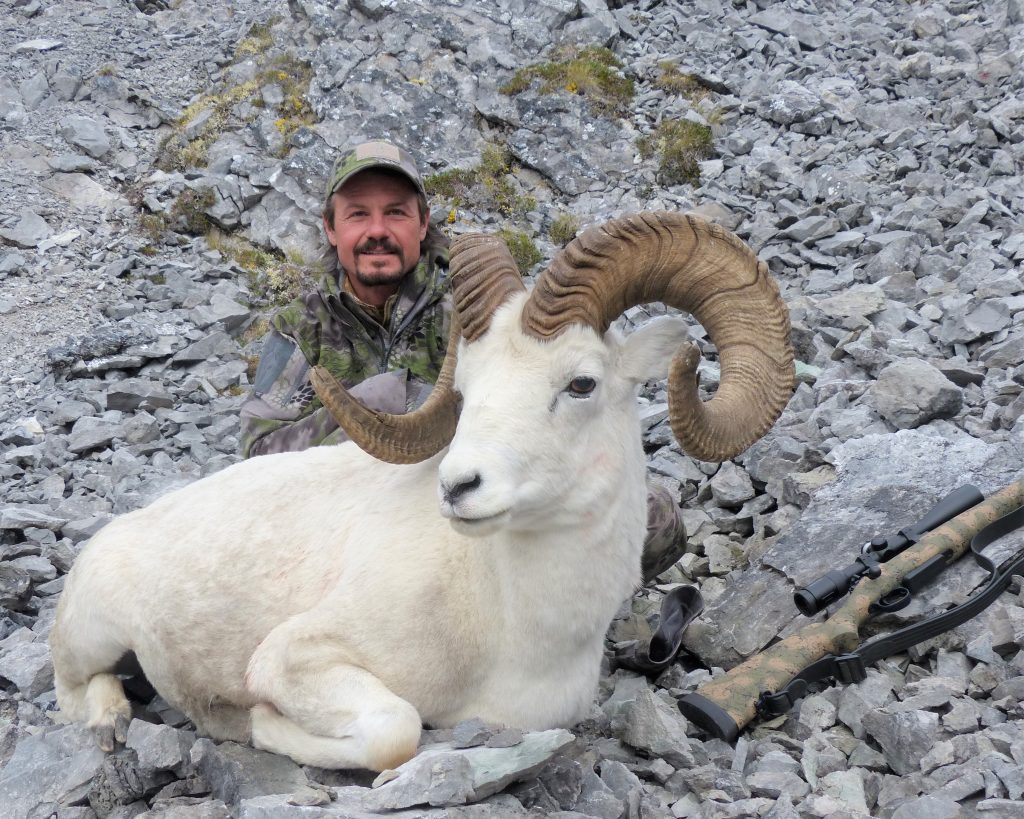
James Reed with his “skookum” ram.
I sat watching the other rams as they simply stared down the hill at their fallen comrade. Only after we stood and began making our way down the slope did they slowly move over a hundred yards or so and began feeding again. Obviously, we were the first humans these rams had ever encountered.
Upon reaching the ram I just stood and admired him for a bit before finally reaching down and touching his great horns. He was truly magnificent. I counted his age rings on his battle-scarred horns and he seemed to be 11½ years old. This is what we had come for: an old mountain monarch that had likely never been hunted by humans in his lifetime. I was humbled and honored just to be in his presence, in his world.
After pictures and processing the ram we donned our now extremely heavy packs and began making our way back up to the ridge top then back to camp. We reached camp about 1 a.m. and devoured a round of Mountain House each, then fell into our tents. The next day we fleshed the hide, packed up, and began our arduous pack out.
With packs weighing 80 to 90 pounds each, we trudged more than twenty miles over two mountain passes and through leg-killing tussocks and swamp. At times we could go only 20 or 30 yards before taking a break. I think each of us reached our breaking point a few times, but took turns encouraging each other to trudge on.
Upon finally reaching the landing strip a day a half later, we were seriously exhausted, but so joyful for experiencing the adventure and our success. All the hard work and unknowns made this hunt all the more rewarding. We had a beautiful ram, a dream ram of a lifetime, a true skookum ram.
Author’s note: Lyle Becker’s Alaska Skookum Guides will be now offering two sheep hunts a year in this area along with his grizzly, moose, caribou, and peninsula brown bear hunts. Learn more at alaskaskookumguides.com.
Serious Mountain Gear
On this hunt I knew every piece of gear I took would be vital not only to my chances of success but even to my survival. I needed everything to be light, tough, and functional because there was no room for extra gear or weight. One essential part of my kit was my pack. I have a hard time finding packs that fit my 29-inch waist and 145-pound frame. For this hunt I chose a Stone Glacier Sky Talus pack and it was truly exceptional. My load on the way out was 80 pounds, and I carried it more than twenty miles.
I used Kryptek’s Altitude series, featuring Schoeller fabrics. These kept me warm and dry even in the daily rain and snow we experienced, plus the numerous river crossings. Every piece from base layers to outer layers to the gloves and gators performed flawlessly.
I used Zeiss’s new Victory RF 10×42 binocular, and their clarity made the hours of glassing every day possible without eye fatigue and with the capability to load my ballistic data into them made a perfect shot possible. For a rifle I cannot speak highly enough of the HS Precision PHL in 6.5 Creedmoor. Topped with a Swarovski 3-18x scope and shooting Hornady Precision Hunter 143-grain ELD-X ammo, this combination was a tackdriver straight out of the box. And a dream to carry weighing in at only 6 pounds with scope.
The foundation of success was my Kenetrek Mountain Hunter Extreme boots and Kenetrek socks, which have served me well for three years on several mountain hunts.—J.C.R.

